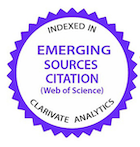Formação de biofilme após estresse subletal por vibrio parahaemolyticus isolados de camarão-rosa (farfantepenaeus paulensis)
DOI:
https://doi.org/10.1590/1089-6891v18e-44246Palavras-chave:
Camarão-rosa, Contaminação, Doenças transmitidas por alimentosResumo
O consumo de frutos do mar, como o camarão-rosa, contaminados com V. parahaemolyticus pode causar gastrenterite aguda. O objetivo deste trabalho foi verificar a capacidade de V. parahaemolyticus isolados de camarões provenientes do estuário da Lagoa dos Patos formarem biofilme após exposição a diferentes tipos de estresse subletal. Para obtenção das amostras, foram realizadas 12 coletas de Farfantepenaeus paulensis, durante o período de safra de 2016. As amostras foram analisadas quanto à presença de V. parahaemolyticus. As cepas foram avaliadas quanto à capacidade de produção de biofilme em placas de microtitulação, tanto antes como após serem submetidas a diferentes tipos de estresse subletal. V. parahaemolyticus foi isolado de 16,66% (2/12) das amostras. Uma das duas cepas isoladas foi capaz de formar biofilme, sendo classificada como fraca formadora de biofilme, a outra foi classificada como não formadora de biofilme. Nenhuma das cepas alterou sua capacidade de formar biofilme quando submetida aos estresses de 4 °C e 20 °C; contudo, com relação aos estresses de 42 °C e pH ácido, cada cepa respondeu de uma maneira diferente.
Palavras-chave: camarão-rosa; contaminação; doenças transmitidas por alimentos.
Downloads
Publicado
Como Citar
Edição
Seção
Licença
Copyright (c) 2017 Ciência Animal Brasileira

Este trabalho está licenciado sob uma licença Creative Commons Attribution 4.0 International License.
Autores que publicam nesta revista concordam com os seguintes termos:
- Autores mantém os direitos autorais e concedem à revista o direito de primeira publicação, com o trabalho simultaneamente licenciado sob a Licença Creative Commons Attribution que permite o compartilhamento do trabalho com reconhecimento da autoria e publicação inicial nesta revista.
- Autores têm autorização para assumir contratos adicionais separadamente, para distribuição não-exclusiva da versão do trabalho publicada nesta revista (ex.: publicar em repositório institucional ou como capítulo de livro), com reconhecimento de autoria e publicação inicial nesta revista.
- Autores têm permissão e são estimulados a publicar e distribuir seu trabalho online (ex.: em repositórios institucionais ou na sua página pessoal) a qualquer ponto antes ou durante o processo editorial, já que isso pode gerar alterações produtivas, bem como aumentar o impacto e a citação do trabalho publicado (Veja O Efeito do Acesso Livre).






























